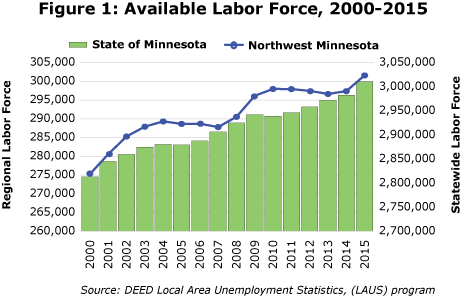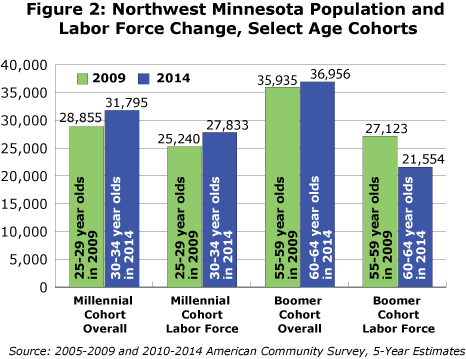
by Chet Bodin and Cameron Macht
June 2016
With an aging workforce, the region must find new workers in the coming years.
The labor force in Northwest Minnesota has experienced the second-fastest growth rate in the state since 2000, behind only Central Minnesota. The 26-county Northwest region added 26,000 workers over the past 15 years and is now home to a labor force of over 301,600, about 10 percent of the state's workers (see Figure 1).

The region's labor market has ebbed and flowed over the past 15 years, with significant growth during recessions – mostly as a result of women with children at home coming into the labor force – followed by relative stability during recoveries.
Northwest added almost 12,700 workers from 2000 to 2003, then held steady until the 2007 recession, when more than 10,000 workers entered the labor force between 2008 and 2010. The labor force then declined slightly from 2010 to 2014, before jumping by over 4,200 in 2015. This growth is notable for its size as well as timing, occurring during an expansion.
At the same time that the size of the labor force and the number of employed workers were growing in the last two years, unemployment in the region was dropping. Northwest is now home to just 14,000 unemployed workers, yielding an unemployment rate of 4.6 percent in 2015. That is the third-lowest rate in the region over the past 25 years, similar to rates last reported in the late 1990s and early 2000s.
Northwest, however, has historically maintained the second-highest unemployment rate of the six planning regions in the state. The region is home to areas of both high and low unemployment, with county unemployment rates ranging from 2.8 percent in Stevens County, the third lowest of the state's 87 counties in 2015, to 9.2 percent in Clearwater County, the highest.
With just 64.6 percent of the population ages 16 and over in the labor force, Northwest has the second-lowest labor force participation rate of the state's six regions. While much of this is due to an older population, the region also has lower participation rates than the state in every age group, with the exception of 16 to 19 year olds (see Table 1).
| Northwest Minnesota Employment Characteristics, 2014 | |||||
|---|---|---|---|---|---|
| Northwest Minnesota | Minnesota | ||||
| Employment Characteristics by Age Group | In Labor Force | Labor Force Participation Rate | Unemployment Rate | Labor Force Participation Rate | Unemployment Rate |
| Total Labor Force | 286,124 | 64.6% | 6.2% | 70.1% | 6.5% |
| 16 to 19 years | 16,854 | 55.4% | 14.3% | 51.1% | 18.7% |
| 20 to 24 years | 28,203 | 80.0% | 10.2% | 81.8% | 10.2% |
| 25 to 44 years | 105,456 | 87.5% | 5.9% | 88.1% | 5.8% |
| 45 to 54 years | 67,117 | 86.3% | 4.7% | 87.3% | 5.0% |
| 55 to 64 years | 53,063 | 68.5% | 4.7% | 71.8% | 4.9% |
| 65 to 74 years | 12,791 | 23.7% | 3.7% | 26.6% | 4.1% |
| 75 years and over | 2,703 | 5.7% | 3.5% | 5.9% | 3.5% |
| Source: 2010-2014 American Community Survey, 5-Year Estimates | |||||
The largest segment of the region's labor force is in their prime working years, from 25 to 54, accounting for 60.3 percent of the total. However, that is about 4.5 percent lower than statewide and a 2 percent decline from 2009.
Instead, the workforce trended older because of aging baby boomers. The number of workers 55 and over increased 20 percent from 2009 to 2014, a shift of nearly 11,500 workers. The sheer size of the aging workforce has outweighed the falling labor force participation rates.
Migration patterns of younger and older workers show an encouraging trend in the region.
There were more 30 to 34 year olds in 2014 than in 2009, when the same group was 25 to 29 year olds, creating a net gain for the region. Overall, this "millennial" cohort increased by nearly 3,000 people in Northwest Minnesota (see Figure 2, first two bars), with an increase of 2,600 people in the labor force (Figure 2, second two bars). Since this age group's labor force participation rate was approximately 87.5 percent in both 2009 and 2014, most of the increase can be attributed to in-migration.

At the other end of the prime working-age spectrum, Northwest Minnesota saw in-migration of older residents, though not necessarily for work. The region gained more than 1,000 baby boomers from 2009 to 2014, but lost about 5,500 from the available workforce as participation rates dropped.
Mirroring overall labor force participation rates in Northwest Minnesota, most race groups also have lower rates than the state, with the exception of American Indians, the largest minority group in the region. Like the state, the region also has huge racial unemployment rate disparities, with the exception of Asians (see Table 2).
| Employment Characteristics by Race, Hispanic Origin, and Disability | |||||
|---|---|---|---|---|---|
| Northwest Minnesota | Minnesota | ||||
| In Labor Force | Labor Force Participation Rate | Unemployment Rate | Labor Force Participation Rate | Unemployment Rate | |
| Employment Characteristics by Race and Hispanic Origin | |||||
| White alone | 267,956 | 64.7% | 5.5% | 70.2% | 5.6% |
| Black or African American | 1,836 | 62.6% | 15.1% | 68.0% | 16.4% |
| American Indian | 8,852 | 61.5% | 21.6% | 59.4% | 17.4% |
| Asian or Other Pacific Islanders | 2,157 | 70.7% | 5.8% | 70.6% | 7.2% |
| Some Other Race | 1,647 | 68.1% | 12.0% | 76.2% | 11.0% |
| Two or More Races | 3,759 | 64.7% | 12.8% | 69.5% | 13.2% |
| Hispanic or Latino origin | 5,845 | 70.4% | 13.5% | 75.0% | 10.1% |
| Employment Characteristics by Disability Status | |||||
| With Any Disability | 16,367 | 50.1% | 12.0% | 51.0% | 14.0% |
| Source: 2010-2014 American Community Survey, 5-Year Estimates | |||||
The regional unemployment rate for black workers is nearly three times higher than for white workers, and the rate is higher than for workers of "some other race," two or more races, Hispanic origin or with any disability. American Indians have the highest regional unemployment disparity – 15 percent higher than white workers.
The region's minority populations offer a grand opportunity to counter labor force contraction resulting from the region's aging population. Bringing unemployment rates for workers of other races down to those of white residents would add 2,500 employed workers and cut the unemployment rate for workers with disabilities in half would add 1,000 employed workers.
Matching available workers with available jobs will become even more important in the future if the region's current labor force participation rates hold steady. Though not reflective of the recent labor force surge, population projections from the Minnesota State Demographic Center indicate a 1.6 percent workforce decline by 2025 (see Table 3).
| Northwest Minnesota Labor Force Projections, 2015-2025 | ||||
|---|---|---|---|---|
| 2015 Labor Force | 2025 Labor Force Projection | 2015-2025 Change | ||
| Numeric | Percent | |||
| 16 to 19 years | 19,923 | 19,297 | -626 | -3.1% |
| 20 to 24 years | 28,296 | 29,795 | +1,499 | +5.3% |
| 25 to 44 years | 106,012 | 114,631 | +8,619 | +8.1% |
| 45 to 54 years | 64,686 | 49,947 | -14,739 | -22.8% |
| 55 to 64 years | 55,786 | 50,580 | -5,206 | -9.3% |
| 65 to 74 years | 14,556 | 18,940 | +4,384 | +30.1% |
| 75 years and over | 3,205 | 4,469 | +1,263 | +39.4% |
| Total Labor Force | 292,464 | 287,658 | -4,807 | -1.6% |
| Source: Minnesota State Demographic Center | ||||
In addition, the labor force will continue to age with rapid gains in the number of workers over 65 and huge declines in the number of 45 to 64 year olds. New labor force entrants are expected to make up for some of this difference, but not all. More in-migration might help lead to an 8.1 percent increase in 25 to 44 year olds by 2025. The overall numbers, however, indicate a tighter labor market in the next decade. Regional employers will need to adjust.
Across all industries, the number of jobs held by workers 55 to 64 in the region increased by 50 percent over the past decade, from 28,092 workers in 2005 to 42,028 in 2015. Across the region, workers 55 and over now hold one-quarter of all jobs, up from 17.5 percent 10 years ago.
Certain industries will be more affected by the aging workforce than others. The industry with the highest concentration of workers 55 and over is transportation and warehousing, at nearly 40 percent. Shortages, however, will be most acute in the region's large education and health care services sectors, which will have the most replacement needs in the next decade. Combined with manufacturing, these three industries account for almost 45 percent of the jobs held by workers 55 and over in the region (see Table 4).
| Northwest Minnesota Workforce by Industry, Second Quarter 2015 | |||
|---|---|---|---|
| Total Workers | Jobs Held by Workers 55 Years and Over | ||
| Number | Number | Percent | |
| Total, All Industries | 218,974 | 55,275 | 25.2% |
| Health Care and Social Assistance | 38,314 | 9,894 | 25.8% |
| Manufacturing | 28,239 | 6,570 | 23.3% |
| Retail Trade | 26,925 | 6,896 | 25.6% |
| Educational Services | 25,434 | 8,231 | 32.4% |
| Accommodation and Food Services | 18,927 | 2,187 | 11.6% |
| Public Administration | 14,955 | 4,216 | 28.2% |
| Wholesale Trade | 12,505 | 3,074 | 24.6% |
| Construction | 9,842 | 1,885 | 19.2% |
| Other Services | 6,875 | 2,005 | 29.2% |
| Finance and Insurance | 5,746 | 1,744 | 30.4% |
| Transportation and Warehousing | 5,389 | 2,116 | 39.3% |
| Admin. Support and Waste Mgmt. Services | 4,703 | 1,012 | 21.5% |
| Professional, Scientific, and Technical Services | 4,769 | 1,240 | 26.0% |
| Agriculture, Forestry, Fishing and Hunting | 4,699 | 1,094 | 23.3% |
| Arts, Entertainment and Recreation | 4,402 | 1,024 | 23.3% |
| Information | 3,009 | 759 | 25.2% |
| Real Estate, Rental and Leasing | 1,580 | 543 | 34.4% |
| Utilities | 1,325 | 414 | 31.2% |
| Management of Companies | 963 | 237 | 24.6% |
| Mining, Quarrying and Extraction | 244 | 81 | 33.2% |
| Source: DEED Quarterly Workforce Indicators (QWI) program | |||